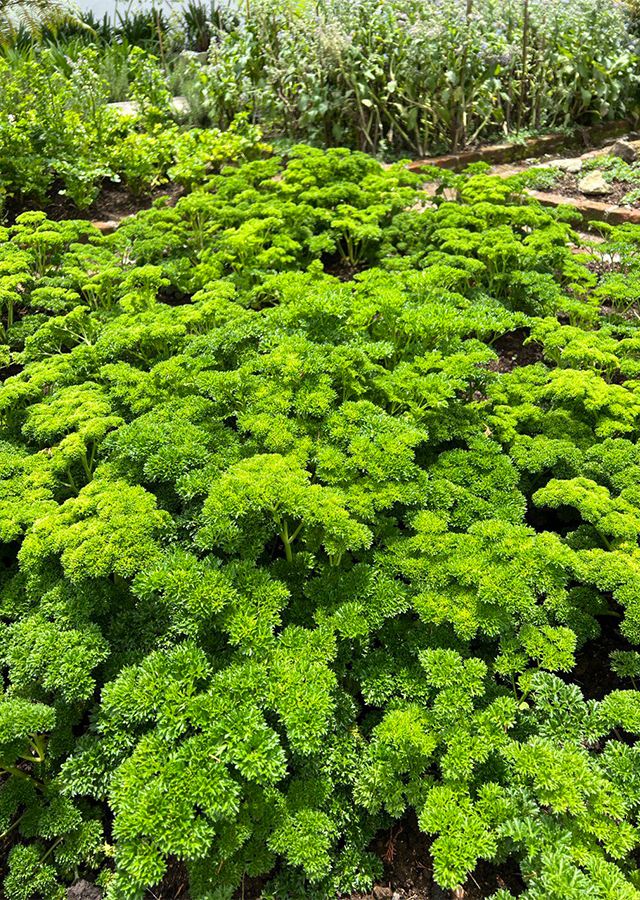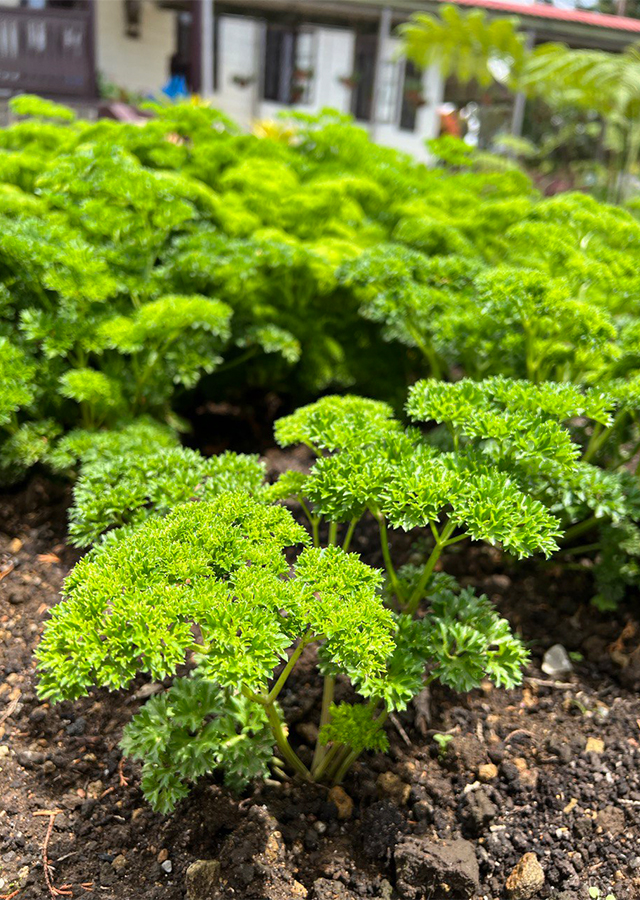Traditional Herbs from Petroselinum crispum
relieve_bites_and_stings
- Prepare enough fresh parsley leaves, wash them thoroughly.
- Crush them until they become a paste.
- Apply the leaf paste on the skin affected by bites or stings.
prevent_hair_fall
- Prepare parsley leaves fresh enough, wash until clean.
- Crush it until it becomes a paste.
- Squeeze out the water.
- Grease it on the scalp to prevent hair loss.
What is Petroselinum crispum Looks like??



Parts of Petroselinum crispum that could be used
- Leaves", "Seeds", "Roots", "All Parts of the Plant
Petroselinum crispum Distribution
Petroselinum crispum is believed to have originally grown in Sardinia (Mediterranean area) and was cultivated from around the 3rd century BC. Linnaeus stated its wild habitat was Sardinia, from where it was brought to England and apparently first cultivated in England in 1548; Bentham considered it native to the Eastern Mediterranean region; De Candolle from T�rkiye, Algeria and Lebanon. Since its introduction to these islands in the sixteenth century, it has become completely naturalized in various parts of England and Scotland, on old walls and stones. In ancient times, parsley was not only used for culinary and medical purposes, it was subjected to various kinds of superstitious beliefs by the ancient Greeks and Romans. Parsley was valued for its medicinal properties long before it was accepted as a food or spice. Apart from its wide use as a green vegetable and garnish, P. crispum is used for different medicinal purposes in traditional medicine and folklore in different countries.Agroecology of Petroselinum crispum
Parsley is a plant from the temperate zone, but can also be cultivated in subtropical and tropical areas. Parsley, especially the more upright forms, grows quite well in the lowlands of the tropics, although plants generally do better at altitudes above 600 m. It grows best in areas where annual daytime temperatures are in the range of 11 - 20 °C, but can tolerate 7 - 28 °C. When dormant, plants can survive temperatures down to about -5 °C, but young plants can be seriously damaged at 0 °C. Parsley prefers an average annual rainfall in the range of 900 - 1,500 mm, but tolerates 300 - 2,800 mm. Prefers moist, well-drained soil in sun or partial shade. High temperatures can affect growth, so light shade is often helpful. Prefers light soils that are not too light or acidic, grows poorly in light acidic soils. Tolerant of moderate salt levels in the soil. Prefers pH in the range of 6 - 7.5, tolerates 5.3 - 8.3.
Morphology of Petroselinum crispum
- Tap root, slender, fibrous, white and sometimes thickened.
- Stem\u00a0cylindrical, grooved and hollow.
- Leaves arranged alternately, 1-3 pinnately compound, dark green, shiny, flat or rolled and with midrib at base. Longest petiole on lower leaves Long-stalked, with obovate-cuneate to finely linear leaflets, which are divided into acute segments. Higher leaves are gradually less divided while uppermost leaves consist of only a few acute segments.
- Flowers, inflorescences are terminal or axillary umbels of 1-3 rather short foliolate bracts (pedicels) which are 2 to 5 mm long. The flowers are small, yellow-green and bisexual indistinct. The petals consist of 5 petals which are sub-orbicular to obovate, measuring up to 1 mm x 0.5 mm and sub-marginate with an inflected apical lobe. There are 5 stamens. The pistil has an inferior ovary and has 2 carpels where each carpel has a thickened stylopodium, style and spherical stigma. 2 to 3 mm long, ovoid and divides into 2 pepperrps when ripe with 5 narrow ribs each.
- Evovate seeds, 2 to 3 mm long. 3 mm, with remnants of the style protruding at the apex.
Cultivation of Petroselinum crispum
Propagation can be done using seeds. Sow the seeds in a container or seedbed and plant them when they are about 10 cm high. Germination usually occurs in about 7 days at 25 �C, although it can take 4 - 6 weeks. Germination time can be reduced by soaking the seeds for 12 hours in hot water that is allowed to cool quickly, but be careful not to overheat and cook the seeds. Seeds remain viable in normal storage for 2 - 3 years.
Petroselinum crispum, more details :
Chemical Content of Petroselinum crispumFlavonoid and phenolic compounds, especially apiin, apigenin and 6-acetylapiin, essential oils include myristicin and apiol and coumarin.
Benefits of Petroselinum crispum
This plant is used as a diuretic in T�rkiye and a carminative and treatment for gastritis in Peru. P. crispum leaves have been used as an antitussive and diuretic and also in the treatment of kidney stones, hemorrhoids, digestive disorders, blurred vision and dermatitis, treating bleeding, hypertension, hyperlipidemia, liver disorders and diabetes, skin diseases, arterial hypertension, heart disease, lumbago , eczema, nosebleeds, treatment of amenorrhea, dysmenorrhea, prostatitis, bad breath, anemia, hypertension, hyperuricemia, constipation, odontalgia, pain, baldness, induction of abortion, insect bites, overcoming urinary tract disease and management of fluid retention.
Simplisia of Petroselinum crispum
- Prepare enough fresh parsley leaves, wash thoroughly with running water then drain.
- Dry in the sun or in an oven at a temperature\u00a040\u00b0C until the water content\u00a010%.
- Choose using a blender until it becomes powder." ,"Store in a clean and airtight place.
Another Facts for Petroselinum crispum :
Synonym of Petroselinum crispumApium crispum Mill.
Habitus of Petroselinum crispum
Herb. Biennial herb, about 30 - 60 cm high
Habitat of Petroselinum crispum
- Mainland
No comments:
Post a Comment